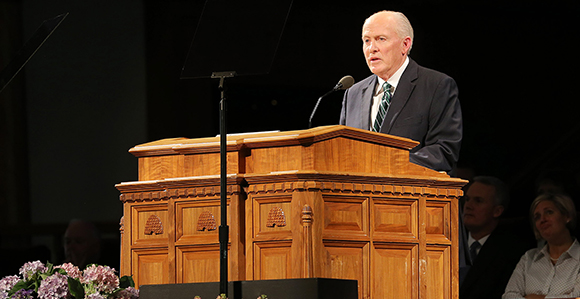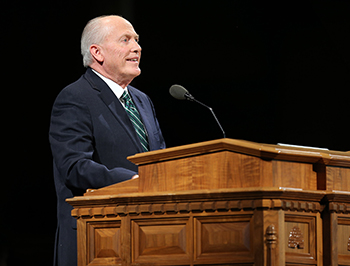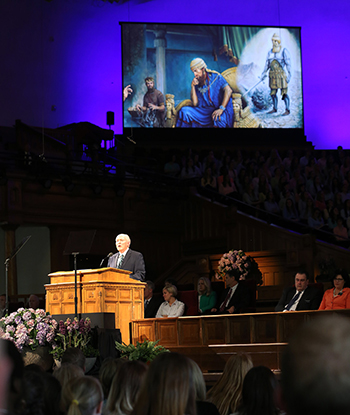Value Truths Learned from First Vision, Elder Maynes Tells Young Adults Worldwide
Contributed By Marianne Holman Prescott, Church News staff writer

Elder Richard J. Maynes speaks during the Worldwide Devotional for Young Adults from the Tabernacle on Temple Square in Salt Lake City Sunday, May 1, 2016.
Article Highlights
- What truths have you learned from Joseph Smith’s First Vision? #LDSdevo
- How has the Lord answered you as you have sought for truth and answers to questions you have had? #LDSdevo
“The First Vision is the key to unlocking many truths that have been hidden for centuries. Let’s not forget or take for granted the many precious truths we have learned from Joseph Smith’s First Vision.” —Elder Richard J. Maynes of the Presidency of the Seventy
Related Links
Different accounts of the First Vision bring a more complete understanding of the sacred experience, Elder Richard J. Maynes of the Presidency of the Seventy taught during a Worldwide Devotional for Young Adults held May 1.
“This experience changed Joseph’s life, it has changed my life, and I know it has or will change your life as you go to the Lord for confirmation of its reality,” Elder Maynes said.
Thousands of young adults—age 18 to 30—from around the world tuned in for the live broadcast originating from the Tabernacle on Temple Square in downtown Salt Lake City. Elder Maynes’s wife, Sister Nancy J. Maynes, shared brief remarks, and a young adult choir comprised of students from the Orem Institute of Religion and high school seniors throughout Utah Valley provided musical selections during the broadcast. Elder John C. Pingree Jr., an Area Seventy, conducted the devotional.
Speaking on the topic “The Truth Restored,” Elder Maynes focused his remarks on the Restoration of the gospel of Jesus Christ and the importance of the First Vision experience of the Prophet Joseph Smith.
“Joseph wrote or dictated four known accounts of his First Vision,” Elder Maynes said. “Additionally, his contemporaries recorded their memories of what they heard Joseph say about the vision; five such accounts are known. It is a blessing to have these records. They make Joseph’s First Vision the best-documented vision in history. I encourage you to visit history.ChurchofJesusChrist.org to learn more about the accounts and see how they work together to paint a more complete picture.”
Drawing from the Gospel Topics essay “First Vision Accounts” found on ChurchofJesusChrist.org, Elder Maynes spoke of the consistency among the accounts, as well as the different emphasis and detail of each account.
Reading from the essay, Elder Maynes said, “Historians expect that when an individual retells an experience in multiple settings to different audiences over many years, each account will emphasize various aspects of the experience and contain unique details.”
Just as the multiple scriptural accounts of Paul’s vision on the road to Damascus and the Apostles’ experience on the Mount of Transfiguration vary, so does Joseph’s account of the First Vision.
“Yet despite the differences,” Elder Maynes said, again quoting from the essay on ChurchofJesusChrist.org, “a basic consistency remains across all the accounts of the First Vision. Some have mistakenly argued that any variation in the retelling of the story is evidence of fabrication. To the contrary, the rich historical record enables us to learn more about this remarkable event than we could if it were less well documented.”
Elder Maynes briefly reviewed the four accounts written or dictated by Joseph Smith. The first account, written in 1832, includes details about forgiveness and “beautifully emphasizes the Savior’s Atonement and the personal redemption He offered to Joseph,” Elder Maynes said.
The second account comes from Joseph’s journal via scribe and was recorded as Joseph’s description of his vision to Robert Matthews, a visitor to Kirtland, Ohio, in 1835.
“In this account, Joseph testifies that God appeared to him first and then he saw the Savior as well,” Elder Maynes taught.

Elder Richard J. Maynes speaks during the Worldwide Devotional for Young Adults from the Tabernacle on Temple Square in Salt Lake City Sunday, May 1, 2016. Photo by Scott G Winteron, Deseret News.

Elder Richard J. Maynes speaks during the Worldwide Devotional for Young Adults from the Tabernacle on Temple Square in Salt Lake City Sunday, May 1, 2016. Photo by Scott G Winteron, Deseret News.
The third account “was written in the context of great opposition” and comes from Joseph’s Manuscript History. The first draft was written after Joseph fled Kirtland early in 1838, and the second draft was written after his escape from Missouri in 1839. The account, published in 1842 in the Times and Seasons, was included in the Pearl of Great Price in 1851 and later canonized as scripture in 1880.
The fourth account, written in 1842 in response to a request for information from the editor of the Chicago Democrat, John Wentworth, was intended for an audience unfamiliar with Mormon beliefs.
“It is a blessing to have these accounts of Joseph’s First Vision,” Elder Maynes said. “Like the individual New Testament Gospels that together more completely describe Christ’s life and ministry, each one of the accounts describing Joseph’s First Vision adds unique detail and perspective to the total experience. They together tell Joseph’s consistent, harmonious story. They all emphasize that there was confusion and strife among Christian churches, that Joseph desired to know which—if any—was right, that he searched the scriptures and prayed, that a light descended from heaven, and that divine beings appeared and answered his prayer.”
Analyzing Joseph Smith’s account of the First Vision is an “enlightening experience,” Elder Maynes said, because of the “sampling of truths” learned in the “sacred, awe-inspiring experience of Joseph Smith.”
The sacred account teaches about essential truths such as the eternal nature of Heavenly Father and Jesus Christ, the reality of Satan, and the struggle between good and evil. Because of the First Vision, individuals can learn from and know that the scriptures are true and that studying the scriptures brings power and insight. Joseph’s experience teaches that prayers are answered, that every person is created in God’s image, and that God knows each person individually and is aware of their needs and concerns.
“Brothers and sisters, the First Vision is the key to unlocking many truths that have been hidden for centuries,” he said. “Let’s not forget or take for granted the many precious truths we have learned from Joseph Smith’s First Vision.”
Elder Maynes invited listeners to consider two questions and to answer and share them on social media platforms using the search term #LDSdevo: “What truths have you learned from Joseph Smith’s First Vision?” and “How has the Lord answered you as you have sought for truth and answers to questions you have had?”
In her brief remarks, Sister Maynes shared her personal conversion to the gospel as a young adult. She identified with Joseph Smith and his quest for knowledge and considers her conversion story her “most treasured experience.”
“The First Vision was an important part in my conversion,” Sister Maynes said. The truth she felt as she learned about the First Vision helped her know “what she was being taught was true.”
To watch the broadcast, visit the website devotionals.ChurchofJesusChrist.org. Recordings in some other languages will be available by May 6.

Elder Richard J. Maynes speaks during the Worldwide Devotional for Young Adults from the Tabernacle on Temple Square in Salt Lake City Sunday, May 1, 2016. Photo by Scott G Winteron, Deseret News.
